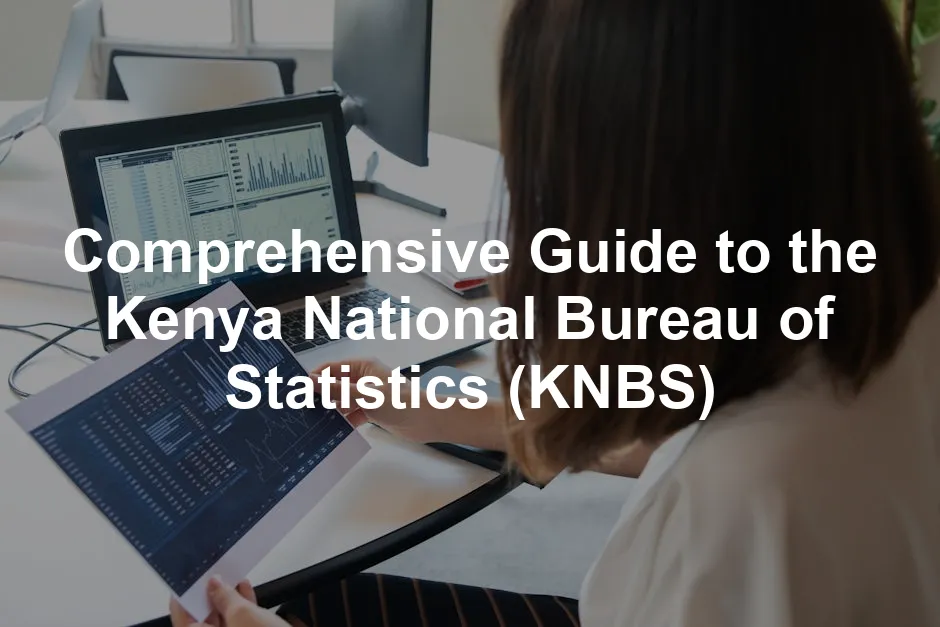Introduction
The Kenya National Bureau of Statistics (KNBS) is the backbone of statistical data in Kenya. Established in 2006, this vital government agency collects, analyzes, and disseminates data that shape the nation’s policies. Think of KNBS as Kenya’s data librarian, ensuring that all information is cataloged and made available to the public.
Why does this matter? In a country where decisions can impact millions, having reliable statistics is essential. KNBS provides data on demographics, economic trends, and social issues, helping policymakers make informed choices. For instance, their findings on poverty rates, currently at 38.6%, highlight the urgent need for socioeconomic interventions.
If you’re a data enthusiast looking to sharpen your skills, consider diving into Statistical Methods for Research and Data Analysis. This book provides a foundation that’s essential for anyone looking to contribute to data-driven decision-making.
This article aims to illuminate the functions and importance of KNBS. We’ll dive into its history, mission, and the organizational structure that makes it tick. You’ll also discover the latest statistics and insights provided by this crucial agency. So, grab your favorite beverage and let’s unravel the fascinating world of statistics in Kenya!

1. Overview of the Kenya National Bureau of Statistics (KNBS)
1.1. History and Establishment
The KNBS was born in 2006, emerging from the Statistics Act. It operates under the Ministry of Planning and is tasked with the monumental job of data collection across various sectors. Since its inception, KNBS has marked notable milestones, including the first Kenya Population and Housing Census in 2009, which laid the groundwork for future data collection efforts.
Fast forward to 2019, and the KNBS conducted a census that recorded a population of 47.6 million. This was a significant step in understanding demographic changes, alongside a host of other social and economic factors. Over the years, KNBS has embraced technology, enhancing its data collection methods and ensuring that statistics are both timely and relevant.
1.2. Mission and Vision
KNBS has a clear mission: to provide and promote quality statistics for evidence-based decision-making. Its vision is to be a world-class statistical agency, renowned for reliability and integrity. This commitment to high standards ensures that data is not just numbers on a page but valuable tools for understanding national trends and challenges.
In a nutshell, the agency’s mission drives it to uphold the highest standards in statistical practices, ensuring that data serves the public interest.
1.3. Organizational Structure
The structure of KNBS is designed for efficiency. Headquartered in Herufi House, Nairobi, it employs a skilled workforce. The agency’s organization includes various departments, each focusing on specific data collection areas, such as demographics, agriculture, and economic indicators.
Key personnel lead these departments, ensuring that all statistics are accurate and relevant. The agency also collaborates with other government bodies, fostering a unified approach to data collection and analysis. This collaboration enhances the overall quality and accessibility of statistical information in Kenya.
In conclusion, the KNBS plays a vital role in shaping the nation’s future through data. Its structured approach ensures that the information provided is not only accurate but also instrumental in guiding policies that affect every Kenyan.

2. Key Functions of KNBS
2.1. Data Collection and Management
The Kenya National Bureau of Statistics (KNBS) employs a variety of data collection techniques. These include surveys, censuses, and administrative records. Surveys are frequently conducted to gather specific information from a representative sample of the population. These surveys can range from household surveys that assess living conditions to specialized surveys focusing on economic activity.
Censuses, on the other hand, are large-scale data collection exercises conducted every ten years. The most recent Kenya Population and Housing Census took place in 2019, revealing vital demographic information that aids in national planning. This census not only captures population numbers but also provides insights into housing conditions, education levels, and employment status.
KNBS also utilizes administrative records from other government departments. By leveraging existing data, KNBS enhances efficiency and reduces redundancy in data collection. This integration of administrative data ensures that statistics are comprehensive and reflective of the current situation in Kenya.

2.2. Data Analysis
Once data is collected, the real magic happens. KNBS processes and analyzes this data to extract meaningful insights. Advanced statistical methods are employed to ensure accuracy and relevance. Data cleaning is crucial, as it eliminates errors and inconsistencies that could skew results.
KNBS uses software tools and statistical techniques to analyze trends. For instance, they might examine poverty rates, which currently stand at 38.6%, to identify factors contributing to economic challenges. The insights drawn from this data guide policymakers in crafting effective interventions.
Moreover, KNBS conducts economic analyses to assess growth indicators. For example, the GDP growth rate, reported as 5.0% for the first quarter of 2024, is a critical figure that influences investment decisions and national budgeting. This analytical prowess positions KNBS as a key player in Kenya’s development landscape.
To enhance your own data analysis skills, consider investing in Statistical Analysis Software. This tool is essential for anyone serious about diving deep into data and extracting actionable insights.
For more on enhancing your data insights, check out these tips for effective data analysis in economics and statistics.
2.3. Dissemination of Data
After analysis comes dissemination. KNBS has several methods for sharing data with the public, government, and other stakeholders. Reports are regularly published and made available on their website. These reports cover various topics, including population statistics, economic indicators, and social trends.
Frequency is key. KNBS releases data quarterly, annually, and as needed. For instance, the quarterly Gross Domestic Product reports provide timely insights into the economy’s performance. The Consumer Price Index (CPI) reports, released monthly, keep the public informed about inflation trends.
Formats vary as well. KNBS provides data in PDF files, spreadsheets, and interactive dashboards. These formats cater to different user needs, allowing researchers, policymakers, and the general public to access and utilize the data effectively.

2.4. Collaborations and Partnerships
Collaboration is vital for a robust statistical framework. KNBS partners with local and international organizations for data sharing and research. These partnerships enhance the quality of data collected and analyzed.
For instance, collaborations with universities foster research initiatives, while partnerships with international organizations like the United Nations improve data harmonization practices. Such collaborations ensure that Kenyan statistics align with global standards, enhancing their credibility.
Additionally, KNBS engages with various sectors, including health, education, and agriculture. By working alongside different stakeholders, they can gather diverse data that paints a complete picture of the nation’s status. This collaborative spirit not only enriches the data landscape but also builds trust among users, making KNBS a reliable source of information.
And while we’re at it, if you’re looking for a Portable Projector for Presentations, this is a great way to ensure your findings are shared effectively in any meeting!
In conclusion, the key functions of KNBS—data collection, analysis, dissemination, and collaboration—form a comprehensive system. This ensures that statistical data is accurate, timely, and accessible. With these functions, KNBS supports evidence-based decision-making, ultimately contributing to Kenya’s sustainable development.

3. Latest Publications and Statistics
3.1. Current Population Statistics
As of mid-2024, Kenya’s population stands at approximately 52,428,290. This figure reflects a steady growth trend, with the population density recorded at about 82 people per square kilometer. The gender distribution shows 23,548,100 males and 24,014,700 females, indicating a slightly higher female population. The average household size is around 3.9, with the total number of households estimated at 12,143,900. Demographic trends reveal a youthful population, with a significant portion under the age of 35. This youthful demographic presents both opportunities and challenges for policymakers as they strategize for future economic and social development.

3.2. Economic Indicators
Kenya’s economy is showing resilience with a reported GDP growth rate of 5.0% for the first quarter of 2024. However, the quarterly growth for the second quarter of 2024 decreased slightly to 4.6%. Inflation remains relatively stable, with the Consumer Price Index (CPI) reported at 3.6% as of September 2024.
On the downside, the Producer Price Index (PPI) has dipped to -1.79% in Q2 2024, indicating a contraction in manufacturing prices. The poverty rate remains a pressing issue, with 38.6% of the population living below the national poverty line, highlighting the need for targeted social interventions. Moreover, the balance of payments shows a current account deficit of KSh -104.1 billion for Q2 2024, suggesting challenges in trade and foreign exchange.
For those interested in understanding the underlying factors of these economic indicators, the Economic Indicator Analysis Book is a must-read!
3.3. Sectoral Data Insights
Kenya’s economic landscape is diverse, with key sectors like trade, agriculture, and tourism playing vital roles. Trade statistics reveal a decline in the volume of trade from KSh 333.8 billion in February 2024 to KSh 306.2 billion in March 2024. Exports dropped from KSh 107.4 billion to KSh 97.9 billion during the same period, while imports also decreased from KSh 226.4 billion to KSh 208.2 billion.
In agriculture, tea production fell from 58,966.9 metric tons in January 2024 to 55,447.3 metric tons in February 2024. Conversely, coffee exports saw a rise from 2,745.2 metric tons to 4,291.3 metric tons between February and March 2024, showcasing a positive trend in this sector.
Tourism is on an upward trajectory, with international visitor arrivals increasing by 35.4% from 1,541.0 thousand in 2022 to 2,086.8 thousand in 2023. Visitors to national parks surged by 43.0%, and hotel bed occupancy rates increased by 23.2%. These statistics reflect a rebound in tourism, a sector crucial for Kenya’s economic recovery post-pandemic.

3.4. Recent Reports and Releases
The Kenya National Bureau of Statistics (KNBS) has been busy publishing insightful reports. Recently, they released the Quarterly Gross Domestic Product report for Q2 2024, providing essential data for economic stakeholders. Another key publication is the Quarterly Balance of Payments report, which sheds light on the country’s financial interactions with the rest of the world.
Additionally, the Leading Economic Indicators report published in July 2024 offers an overview of key economic trends, including inflation rates and interest fluctuations. The Consumer Price Indices and Inflation Rates reports for July and September 2024 are also noteworthy, offering timely insights into the cost of living and economic stability.
These publications are vital for researchers, policymakers, and the public, as they provide a transparent look into Kenya’s economic state and demographic shifts. Each report serves as a tool for informed decision-making, guiding strategies that impact every Kenyan.

4. Importance of KNBS in Policy Making
The Kenya National Bureau of Statistics (KNBS) plays a pivotal role in shaping the country’s policies. By providing reliable and accurate data, it ensures that decision-makers have the evidence needed to craft effective programs. Essentially, KNBS is like a trusty compass, guiding the government through the sometimes murky waters of policy-making.
4.1. Evidence-Based Decision Making
In a world where opinions often overshadow facts, KNBS data stands tall. The agency supplies essential statistics that inform government policies across health, education, and infrastructure. For instance, consider the education sector. By analyzing enrollment figures and drop-out rates, KNBS data helps the government allocate resources to schools in need.
Moreover, during the COVID-19 pandemic, KNBS provided vital demographic data, which helped tailor responses to different communities. Policymakers used this data to ensure that assistance reached those most affected. Without such insight, it would have been like trying to find a needle in a haystack—blindfolded!
The agency’s commitment to transparency fosters trust in government initiatives. When citizens see that policies are grounded in solid data, they’re more likely to support them. This evidence-based approach is crucial for nurturing a collaborative relationship between the government and the public, ensuring that everyone is on the same page.

4.2. Impact on National Development
The influence of KNBS data extends to various national development initiatives. One shining example is the Big Four Agenda, which focuses on manufacturing, universal healthcare, affordable housing, and enhancing agricultural production. By providing current data on poverty levels and economic performance, KNBS has enabled the government to identify priority areas.
Take the housing sector, for instance. KNBS statistics revealed that over 61% of Kenyans live in informal settlements. This alarming data prompted the government to fast-track housing projects to address this issue. Statistics from KNBS are not just numbers—they are a call to action!
Similarly, in agriculture, the agency’s reports on crop yields and food security have informed policies aimed at boosting food production. By identifying trends and challenges faced by farmers, KNBS assists in crafting supportive policies that ensure food security for all Kenyans.
KNBS data also plays an essential role in shaping the budget. The agency’s economic indicators help policymakers understand which sectors require more funding or support. This ensures that the national budget reflects the actual needs of the population, leading to effective resource allocation.
In summary, the importance of KNBS in policy-making cannot be overstated. The agency’s data fuels evidence-based decisions, directly impacting national development initiatives. As the voice of statistics in Kenya, KNBS empowers the government and citizens alike to work together towards a better future.

5. Challenges Faced by KNBS
While KNBS is a powerhouse of information, it does face its fair share of challenges. Understanding these hurdles is essential for recognizing the agency’s ongoing efforts to improve its data collection and dissemination processes.
5.1. Data Collection Challenges
Data collection is no walk in the park. KNBS faces numerous challenges, particularly regarding funding and logistics. Budget constraints often limit the scope and frequency of surveys. With limited resources, it becomes difficult to reach remote areas, leading to gaps in data.
Moreover, logistics can be a nightmare. The vastness of Kenya means that traversing rural areas to gather data is a Herculean task. Many field officers brave the elements to collect accurate information, but transportation issues can hinder their efforts. Imagine trying to gather data while navigating bumpy roads or unexpected weather changes—it’s enough to make anyone pull their hair out!
To make field data collection easier, consider using a Digital Notepad for Field Data Collection. It simplifies the process and ensures that no data gets lost in translation!

5.2. Public Perception and Trust
Public trust in government statistics is another significant challenge. Many citizens remain skeptical about the accuracy of data provided by KNBS. This skepticism often stems from past experiences where data has been misused or misrepresented.
KNBS is actively working to rebuild this trust by ensuring transparency in its operations. Regularly publishing methodologies and engaging with the public helps demystify the data collection process. When citizens understand how data is gathered, they are more likely to view it as credible.

5.3. Technological Advancements
Keeping pace with technological changes in data collection and analysis poses another challenge. As technology evolves, so do the methods for gathering and processing data. KNBS must invest in new tools and training to ensure staff are equipped with the latest skills.
While technology can streamline data collection, the initial costs can be daunting. KNBS must balance modernizing its processes without compromising its budget. This juggling act requires careful planning and foresight.
In conclusion, while KNBS faces several challenges, its commitment to overcoming these obstacles is commendable. By addressing funding issues, rebuilding trust, and embracing technology, the agency can continue to provide the invaluable data that supports Kenya’s development initiatives.

6. Future Directions and Opportunities
6.1. Upcoming Projects and Surveys
The Kenya National Bureau of Statistics (KNBS) is gearing up for exciting new initiatives. One of the highlights on the horizon is the 2024 Remittances Household Pilot Survey. This survey aims to gather vital data on remittances, which play a crucial role in the economy. Remittances have been a lifeline for many households, so understanding their impact is essential for policy formulation. This survey will not only provide insights into the financial flows into the country but will also help assess their effects on poverty and economic growth.
The KNBS is committed to ensuring that the data collected is representative and comprehensive. By engaging with various stakeholders, including communities receiving remittances, the bureau aims to paint a clear picture of the remittance landscape in Kenya. This initiative is a step toward better understanding how external financial resources contribute to local economies.

6.2. Enhancements in Data Collection
In an era where data drives decisions, KNBS recognizes the need for continuous improvements in data collection methods. The agency is set to enhance its data collection techniques and technology significantly. Plans are underway to incorporate more digital tools and platforms in its operations. This includes mobile data collection applications that can streamline the survey process and ensure real-time data entry.
The use of advanced technology will not only improve the accuracy of data but also increase efficiency. For instance, integrating Geographic Information Systems (GIS) will allow for better geographic data analysis, helping to identify regional disparities and inform targeted interventions. By embracing innovation, KNBS aims to keep pace with the rapidly changing data landscape and ensure that the information it provides is both timely and relevant.
If you’re looking for the right tools to support your data collection efforts, consider a Mobile Wi-Fi Hotspot for Internet Access in Remote Areas. It ensures that you stay connected, even when you’re out in the field!
6.3. Career Opportunities at KNBS
As KNBS expands its initiatives and embraces new technologies, the demand for skilled professionals is on the rise. Career opportunities within KNBS are not just jobs; they are chances to contribute to meaningful change in Kenya. The agency seeks individuals who are passionate about data and its transformative potential.
Workforce development is a priority for KNBS. The agency understands that a well-trained workforce is essential for achieving its goals. By investing in training programs and workshops, KNBS aims to nurture talent and prepare its employees for the challenges ahead. This commitment to professional growth creates an environment where innovation and creativity can flourish.
If you’re considering a career in statistics, data analysis, or research, KNBS offers a dynamic work environment. Joining the team means becoming part of a vital mission—providing accurate and timely data that informs policy and drives national development.
In summary, the future looks bright for KNBS, with exciting projects and a commitment to enhancing data collection techniques. The agency’s focus on workforce development ensures that it will continue to play a pivotal role in shaping the statistical landscape in Kenya.

FAQs
What is the primary role of the Kenya National Bureau of Statistics?
The Kenya National Bureau of Statistics (KNBS) is responsible for collecting, analyzing, and disseminating statistical data critical for evidence-based policy-making in Kenya. This includes conducting surveys, censuses, and managing data for various sectors.
How often does KNBS conduct censuses?
KNBS conducts censuses every ten years. The most recent Kenya Population and Housing Census occurred in 2019. These comprehensive data collection exercises are essential for understanding demographic changes and planning.
Where can I access KNBS publications and data?
You can access KNBS publications and data on their official website. The site provides a variety of reports, statistics, and resources available for public use, ensuring transparency and accessibility.
How does KNBS ensure the accuracy of its data?
KNBS employs rigorous data collection methodologies and statistical techniques to ensure accuracy. Regular training for staff and adherence to best practices in data management also contribute to maintaining data integrity.
Can individuals participate in KNBS surveys?
Yes! KNBS encourages individuals to participate in surveys. Your input is invaluable for collecting accurate data that reflects the reality of life in Kenya. Participation helps inform policies that directly affect your community.
Please let us know what you think about our content by leaving a comment down below!
Thank you for reading till here 🙂
All images from Pexels




